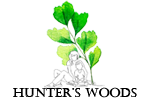Montessori Materials
A Checklist of (Affordable) Sensorial Montessori Materials to Get a Child Age 2-6
Is your child between 2 to 6 years old? Here's a quick list of the officially recommended sensorial Montessori materials for early childhood -- and where to get them if you're based in the Philippines.
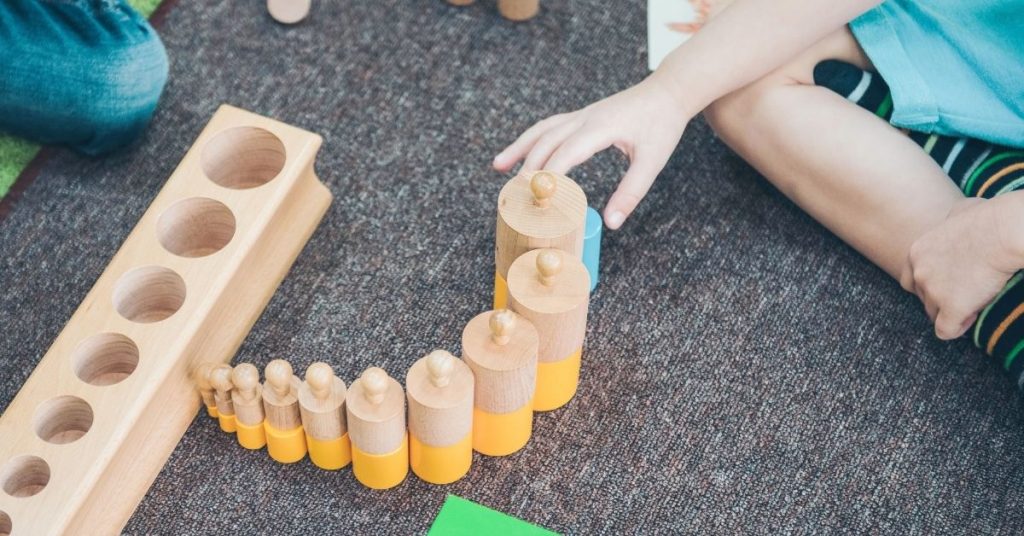
If your child is between 2 years old and 6 years old, he or she will benefit from hands-on time with these sensorial Montessori materials that are recommended for early childhood, whether you’re doing a structured Montessori homeschooling program or just cherry-picking the aspects of Montessori that you think would help your child most.
Note: The list below contains descriptions but, as you work with these materials with your child, it would be ideal if you read up on how to best present them to your child, and how to work with them, so that your child can get the most benefit out of them. We’re always reminded that “You can do Montessori without the materials but you can’t do Montessori without the philosophy” and how your child interacts with these materials can be just as important as having these materials.
What Are Montessori Materials?
This is a quick introduction just in case you aren’t familiar with the Montessori way yet.
“Materials” are learning tools that are a hallmark of Montessori classrooms. Although I’ve just written that they are considered tools, Montessori materials are often colorful, kid-size, and attractive and interesting enough by themselves such that they can be — and often are — used as educational toys for kids, whether or not they are in the Montessori system.
For early childhood — usually defined as kids between 2 to 6 years old — there are recommended materials in the following areas:
Practical Life, Arts and Crafts
Sensorial
Math
Language
Cultural (Geography, History, Natural, and Physical Sciences)
This article will focus on the sensorial Montessori materials.
As their name implies, sensorial materials help a child develop and refine his or her five senses.
This isn’t a full list of all sensorial materials available out there, by any means, but this is the list recommended by the American Montessori Society (AMS).
How Much Do Montessori Materials Usually Cost?
The short answer: it depends!
If you’re working with a limited budget — and most of us are, these days! — make sure you read the descriptions and prioritize the ones that you think will be most useful. Then make a note of the ones that you can improvise or make at home. At the end of each item below, I’ve placed links to where you can buy that particular material from:
Nienhuis – a Montessori materials supplier that is one of only 4 accredited by the Association Montessori Internationale (AMI) and can be considered the gold standard;
Montessori Outlet – an affordable Montessori materials supplier based in California;
Shopee – different shops, some China-based and some located in the Philippines, that sell that specific material. This will be the cheapest option, but as always with Shopee, make sure you read the descriptions, check out the reviews if any, and look at the seller’s overall rating, all of which will give you an idea of what you can expect. For example, the description might tell you that you’re getting a slightly smaller version compared to the standard Nienhuis dimensions — but you could decide that you’re okay with that as a tradeoff for the more budget-friendly price. (And of course, you can then use your Shopee vouchers to get discounts, cashback and/or free shipping.)
I don’t get commissions from any of these shops so it doesn’t matter personally to me where you buy from. My best advice is to choose according to what you feel is right for your family and for your budget.
Montessori Materials for Age 2 to 6: Sensorial
In a hurry? Get a quick checklist of sensorial Montessori materials for early childhood (PDF).
Baric Tablets

Description:
These are tablets with different weights: the first set has tablets that are light (around 20 g); the second has medium-weight tablets (around 30 g); and the third has heavy tablets (around 40 g). The sets have different colors as a means of “control of error” — that is, the colors allow the child to self-correct as he or she works with the tablets and sorts them.
Purpose:
The baric tablets help a child understand the concept of weight.
It may also later help introduce the degrees of comparison of adjectives (positive, comparative and superlative): light-lighter-lightest and heavy-heavier-heaviest.
How to work with baric tablets
Where to buy: Nienhuis $69.90 | Montessori Outlet $39.95 | Not available in Shopee
Bells Set
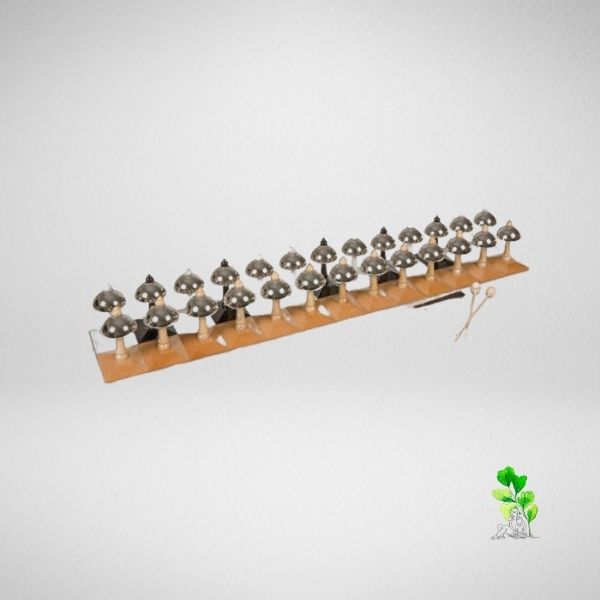
Description:
This is a set of thirteen pairs of bells from Middle C to High C
Purpose:
Activities with these bells will help refine your child’s sense of pitch. (These can be a bit pricey so, if you need an alternative, you can look into ear training apps.)
How to work with Montessori bells
Where to buy: Nienhuis $1033.50 | Not available in Shopee
Binomial Cube
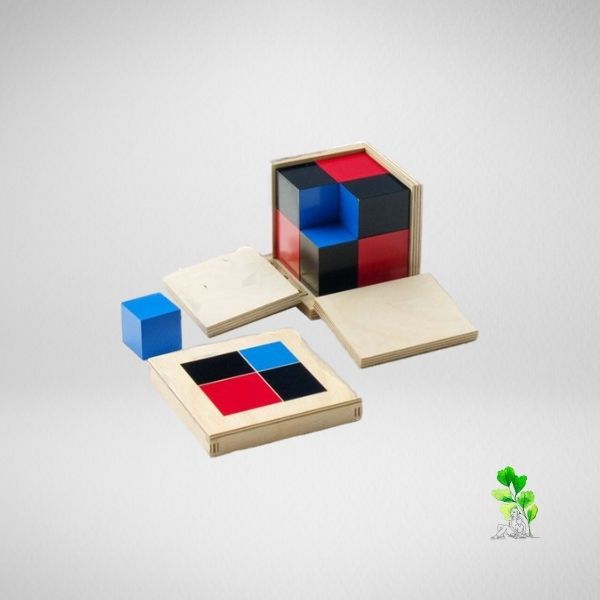
Description:
This consists of eight painted wooden cubes in a wooden box with a lid. The binomial square pattern is printed on the lid, and the box is hinged, opening to display the cubes.
Purpose:
At the age of 2-6, the binomial cube can help improve your child’s understanding of the three dimensions and 3-dimensional puzzles. It will also help prepare your child for mathematical concepts that he or she will be working on in later ages.
How to work with the binomial cube
Where to buy: Nienhuis $106.50 | Montessori Outlet $27.95 | Shopee ₱508
Brown Stairs (Broad Stairs)
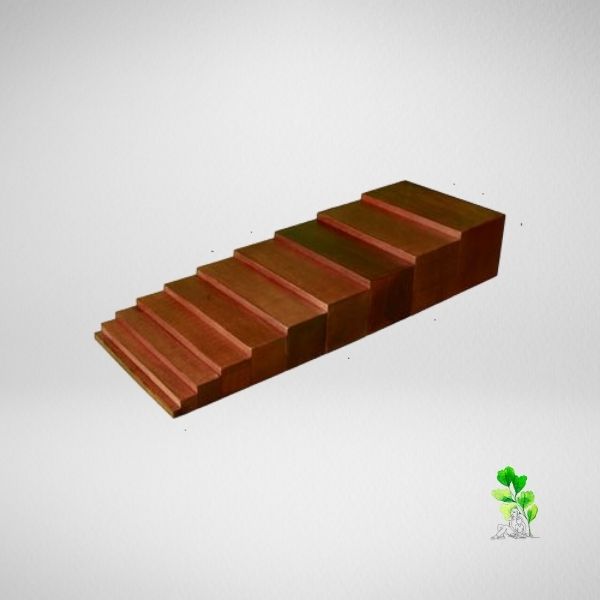
Description:
The brown stairs, also known as broad stairs, are made up of ten wooden prisms that range from 1 cm x 1 cm x 20 cm to 10 cm x 10 cm x 20 cm.
Purpose:
This material acquaints children with different dimensions. As they sort the stairs, they also improve their coordination and concentration and learn the consequence of disorder. In terms of language, this material can also help introduce the degrees of comparison of adjectives (positive, comparative and superlative): thin-thinner-thinnest and thick-thicker-thickest.
How to work with the brown stairs
Where to buy: Nienhuis $162.50 | Montessori Outlet $94.95 | Shopee ₱1,218
Color Tablets
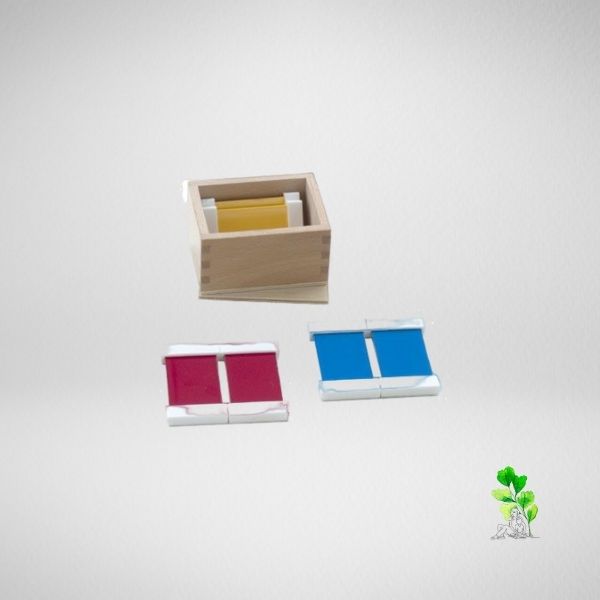
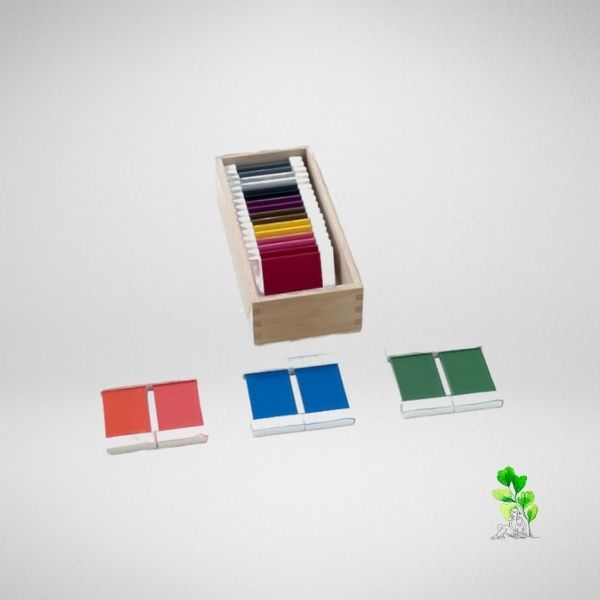
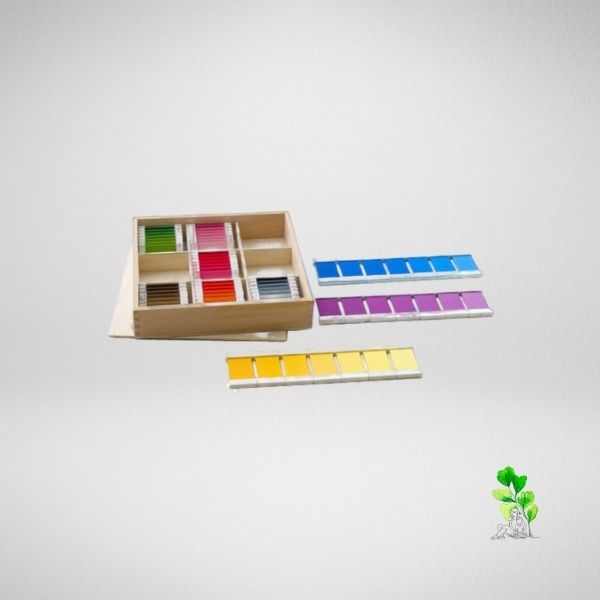
Description:
There are usually three boxes of color tablets, though a fourth box may also be available.
Box 1 contains a pair of tablets for each of the 3 primary colors (red, yellow, blue).
Box 2 contains a pair of tablets for each of the 3 primary colors (red, yellow, blue) and the 3 secondary colors (green, orange, purple). Some boxes may also include pink, brown, black, white, and grey.
Box 3 contains tablets of different shades (usually 7 shades) of the 3 primary colors (red, yellow, blue), the 3 secondary colors (green, orange, purple), and pink, brown, and gray.
Purpose:
This material orients the child to the world of color. As with the other materials, this also helps the child improve concentration and coordination.
How to work with the color tablets
Where to buy:
Nienhuis Box 1 $28.10 | Box 2 $56.20 | Box 3 $151.00 | Box of 32 $141.30
Montessori Outlet Box 1 $11.95 | Box 2 $24.95 | Box 3 $62.95 | Box 4 $59.95
Shopee Box 1 ₱465 | Box 2 ₱790 | Box 3 ₱1395 | Box 4 ₱2139
Constructive Triangles

Description:
The constructive triangles are made up of 5 wooden boxes (two rectangular, two hexagonal, and one triangular) that contain triangles of different sizes, shapes, and colors.
Purpose:
This material lets the child explore and experiment with form. He or she discovers that different types of triangles can be combined to form new shapes and that, in fact, all plane geometric figures can be constructed from triangles (hence the name). Further along, the triangles prepare the child to understand the concept of equivalence and how to find the area of plane figures.
How to work with constructive triangles: Rectangular Triangles | Blue Rectangular Box | Triangular Box | Large Hexagonal Box | Small Hexagonal Box
Where to buy: Nienhuis $299.00 | Montessori Outlet $98.95 | Shopee ₱2,314
Cylinder Blocks (Knobbed Cylinders)
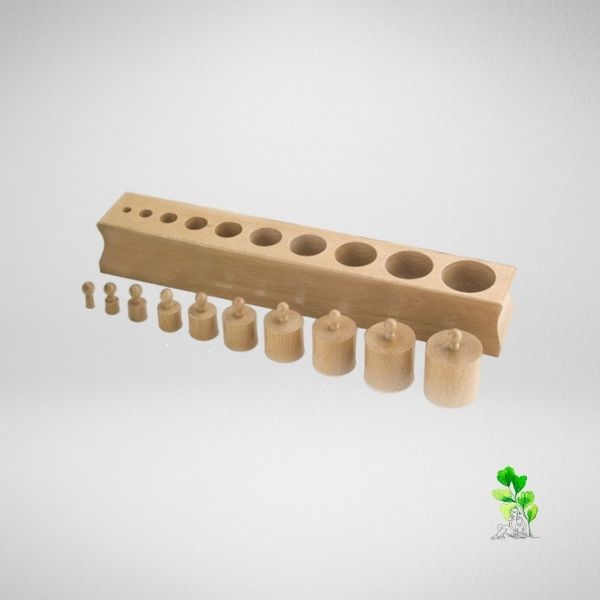
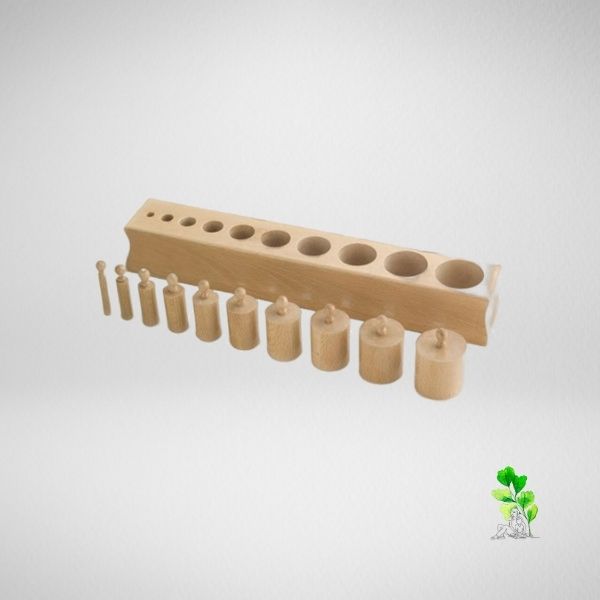
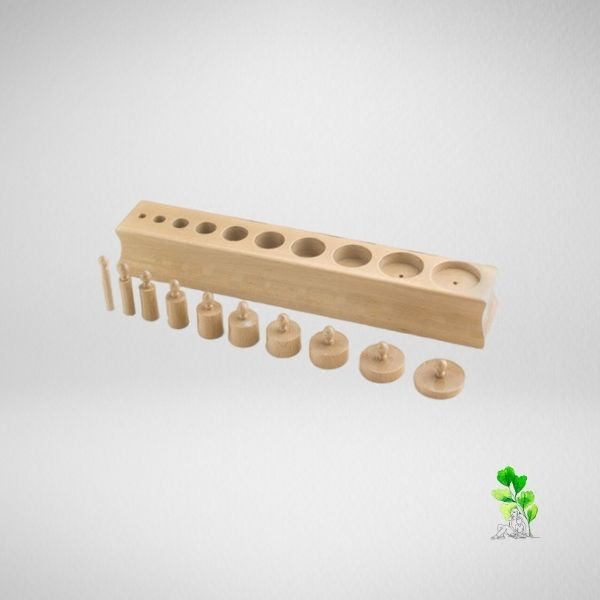
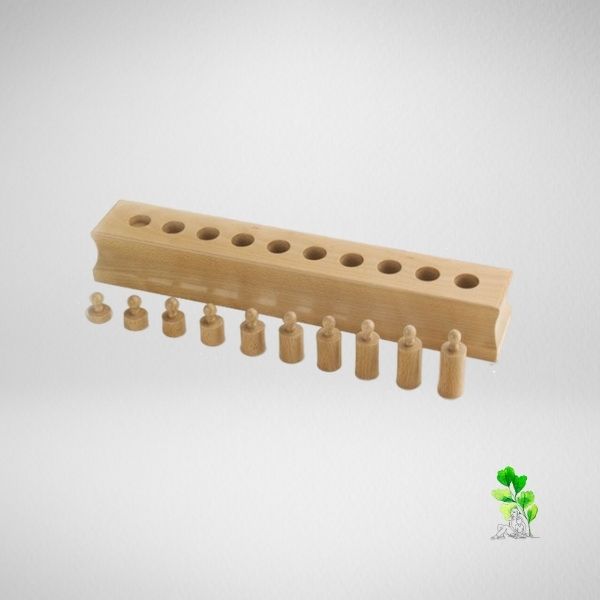
There are 4 blocks, each containing 10 cylinders with knobs. Each cylinder fits into a matching hole.
In Block 1, the cylinders progress in height and diameter from small to large.
In Block 2, the cylinders progress in diameter from thin to thick while height remains constant.
In Block 3, the cylinders progress in diameter from thin to thick while height progresses from tall to short.
In Block 4, the cylinders progress in height from short to tall while diameter remains constant.
Purpose:
The cylinder blocks help the child to improve grip and develop visual discrimination of different heights and diameters.
How to work with cylinder blocks
Where to buy:
Nienhuis Block 1 $82.20 | Block 2 $82.20 | Block 3 $82.20 | Block 4 $82.20
Montessori Outlet Block 1 $39.95 | Block 2 $39.95 | Block 3 $39.95 | Block 4 $39.95
Shopee ₱520
Fabric Box (Touch Fabrics)
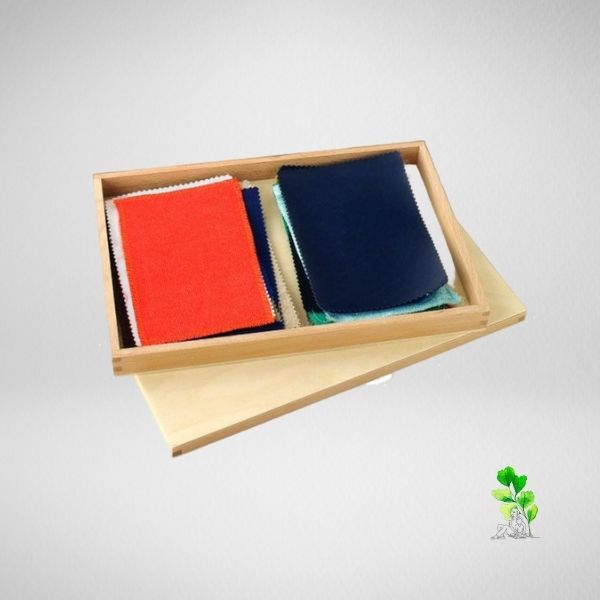
Description:
This material is comprised of a lidded wooden box containing six pairs of fabric pieces, usually cotton, jute, leather, silk, wool, and synthetic.
Purpose:
The fabric box helps enhance the child’s tactile sense. Working with it also improves the child’s concentration and problem solving skills.
How to work with the fabric box
Where to buy: Nienhuis $69.90 | Montessori Outlet $32.95 | Not available in Shopee
Geometric Cabinet
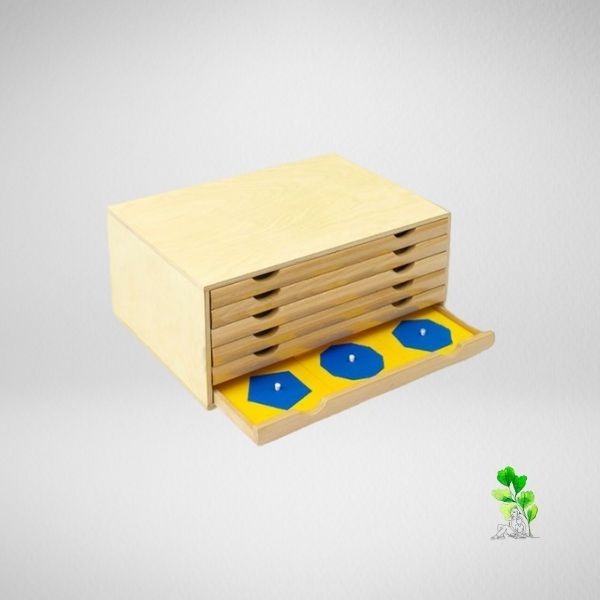
Description:
The standard geometric cabinet contains six drawers with 35 geometric insets and frames, including circles, triangles, rectangles, other quadrilaterals, curvilinear figures, and different regular polygons.
Purpose:
The geometric cabinet will get your child oriented to different shapes. It will also prepare him or her for geometry/mathematics and indirectly prepare his or her hand for writing.
How to work with the geometric cabinet
Where to buy: Nienhuis $511.50 | Montessori Outlet $179.95 | Shopee ₱4,242
Knobless Cylinders
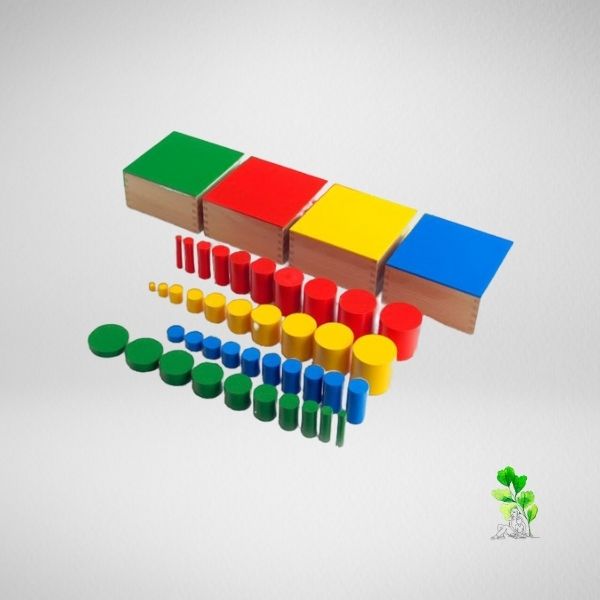
Description:
This material consists of four cylinders with 10 cylinders each.
* Blue set – the cylinders differ in one dimension
* Red set – the cylinders differ in two different dimensions
* Yellow set – the cylinders differ in three different dimensions
* Green set – the cylinders differ in three different dimensions, inverse to the yellow
Purpose:
The knobless cylinders let the child experience differences in height and width and understand the consequence of disorder.
How to work with the knobless cylinders
Where to buy: Nienhuis $199.90 | Montessori Outlet $84.95 | Shopee ₱2790
Mystery Bag

Description:
The “mystery bag” is a cloth bag that contains several familiar objects. A variant of this might be a bag that contains the different geometric solids.
Purpose:
This helps develop the child’s stereognostic sense — his or her ability to perceive and understand the form of an object and thereby identify it based on touch alone, without looking at it, smelling it, tasting it or hearing what sounds it makes.
How to work with the mystery bag
Where to buy: Nienhuis $37.70 | Montessori Outlet $9.95 | Not available in Shopee as a set (but can definitely be improvised!)
Pink Tower
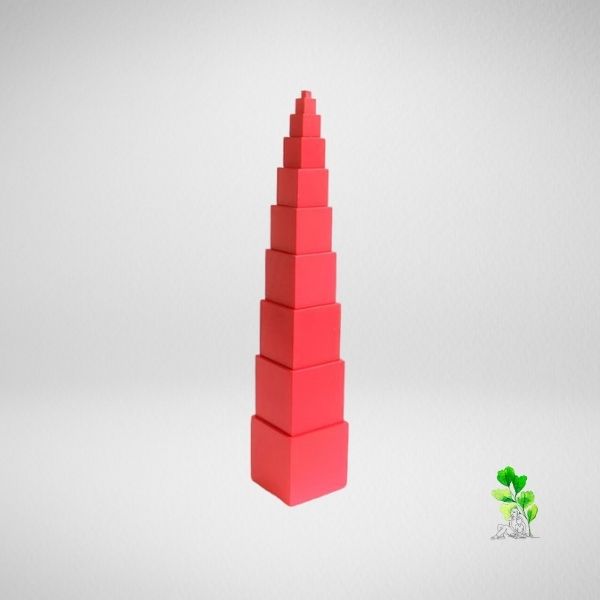
Description:
This material is a set of 10 pink-colored wooden cubes with different dimensions.
Purpose:
The Pink Tower helps the child develop visual discrimination of dimensions. Working with it also helps refine his or her voluntary movement, hand-eye coordination, and concentration.
How to work with the pink tower
Where to buy: Nienhuis $139.60 | Montessori Outlet $54.95 | Shopee ₱620
Red Rods (Long Rods)

Description:
This is a set of 10 red-colored solid wooden rods of different lengths.
Purpose:
The red rods allow the child to experience differences in lengths and realize the consequence of disorder. Working with this material also helps the child develop muscle memory of the rods’ lengths.
Where to buy: Nienhuis $169.50 | Montessori Outlet $58.95 | Shopee ₱920
Rough Gradation Tablets (Touch Tablets)

Description:
This material consists of a wooden box containing five pairs of touch tablets with sandpaper ranging from [relatively] smooth to rough.
Purpose:
The rough gradation tablets helps the child develop his tactile sense by matching rough textures through touch alone. It also helps improve concentration.
How to work with the rough gradation tablets
Where to buy rough gradation tablets: Nienhuis $65.50 | Montessori Outlet $29.95 | Not available in Shopee
Rough and Smooth Boards (Touch Boards)
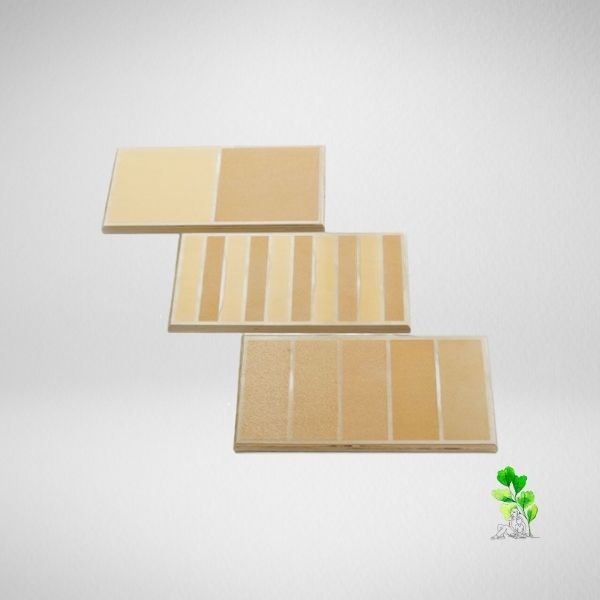
Description:
This is a set of 3 boards:
* Board 1 is divided into two halves, one polished and the other covered in sandpaper.
* Board 2 is divided into ten strips, five polished and five covered in sandpaper.
* Board 3 is divided into five strips covered in sandpaper, ranging from nearly smooth to very rough.
Purpose:
This material introduces the contrast of rough and smooth, refines the child’s tactile sense, helps the child acquire better muscular control through lightness of touch, and encourages the child to build dexterity and coordinate finger movements.
How to work with the rough and smooth boards (touch boards)
Where to buy rough and smooth boards: Nienhuis $35.90 | Montessori Outlet $13.95 | Shopee ₱1,211
Sequence of Sorting Activities

Description:
This work involves a sorting tray and various objects that can be sorted by color, size, shape, types, or other properties. When bought, the sorting set will usually include a tray with several compartments and colored chips of red, yellow, green, and blue. The objects to be sorted may be buttons, seeds, grains, or other items within the environment.
Purpose:
Sorting helps the child practice color discrimination, enhance their stereognostic sense, and improve their fine motor skills.
Where to buy sorting sets: Nienhuis $46.50 | Montessori Outlet $13.95 | Not specifically available in Shopee but easy to improvise
Smelling Bottles/Jars
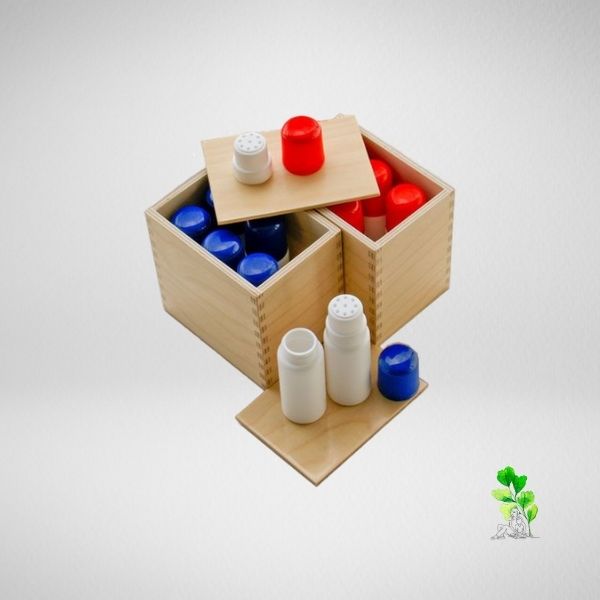
Description:
A Montessori set of smelling bottles will usually be composed of two wooden boxes each containing four to six empty bottles with removable caps. However, this is one of the sensorial materials that you can definitely improvise with items you already have at home. The bottle tops of one box should differ from the tops of the other box, and they should open and close easily.
Purpose:
This activity enhances a child’s sense of smell and improves concentration.
How to work with smelling bottles/jars
Where to buy smelling bottles: Nienhuis $79.50 | Montessori Outlet $22.95 | Shopee ₱1,028
Sound Boxes (Sounds Cylinder)
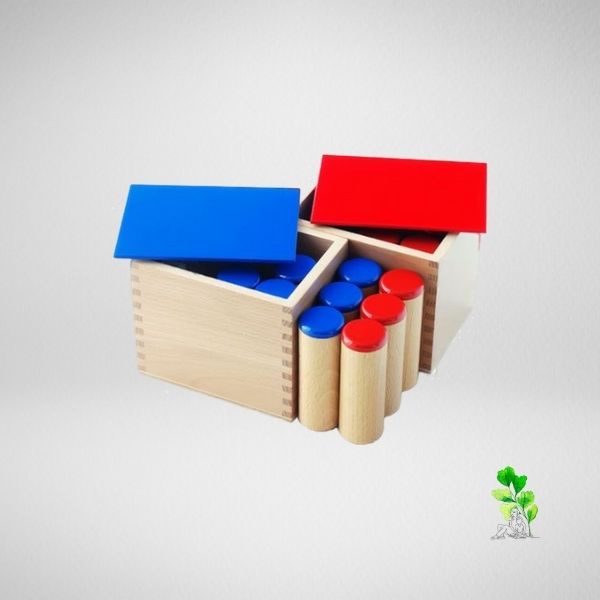
Description:
The sound boxes are composed of 2 sets of 6 sealed wooden cylinders, one set with red tops and the other with blue tops. The cylinders make a distinctive sound when shaken, ranging from very soft to loud, with the sounds in the red set matching their counterpart in the blue set.
Purpose:
This material helps refine the child’s auditory sense as well as helping him or her develop concentration.
Where to buy: Nienhuis $110.10 | Montessori Outlet $59.95 | Shopee ₱908
Tasting Bottles
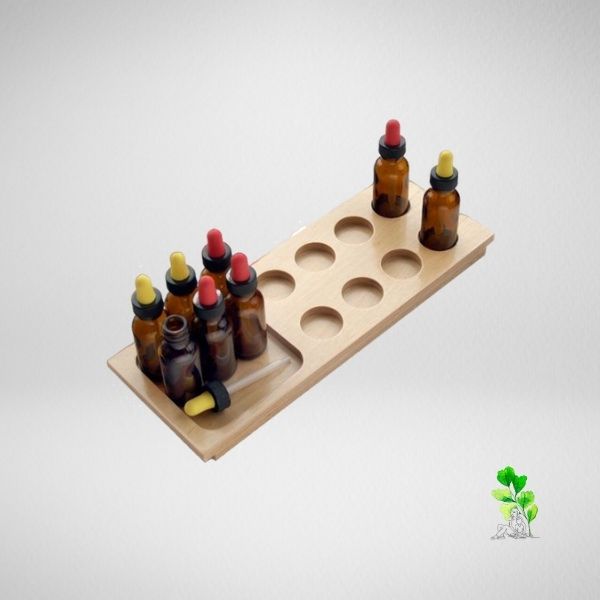
Description:
There are two sets of four bottles with droppers, each containing one of the four fundamental tastes: sweet, sour, salty and bitter. The tastes can be formulated using sugar, lemons, salt, and tonic water, respectively (although substitutes can be used, particularly for the sour and bitter tastes). There should be a way to distinguish the bottles of one set from the bottles of the other, such as different-colored tops or labels.
Purpose:
This material helps enhance the child’s sense of taste. It helps them identify the four fundamental tastes and realize the association between smell and taste.
How to work with tasting bottles
Where to buy: Nienhuis $52.50 | Montessori Outlet $19.95 | Not available in Shopee but can be improvised easily
Thermic Bottles
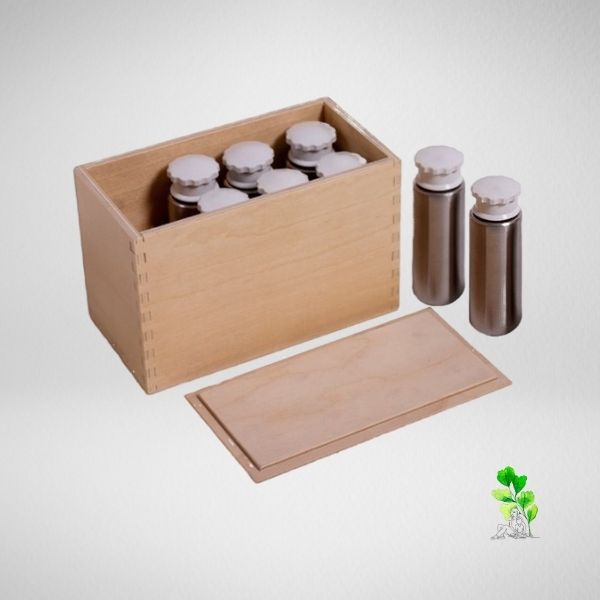
Description:
The thermic bottles are composed of four pairs of metal bottles/containers, with each pair containing water at different temperatures, usually: 17°C, 27°C, 37°C (body temperature), and 47°C.
Purpose:
This material helps develop the child’s thermic sense (ability to distinguish temperature).
How to work with thermic bottles
Where to buy: Nienhuis $210 | Montessori Outlet $66.95 | Shopee ₱1,688
Trinomial Cube
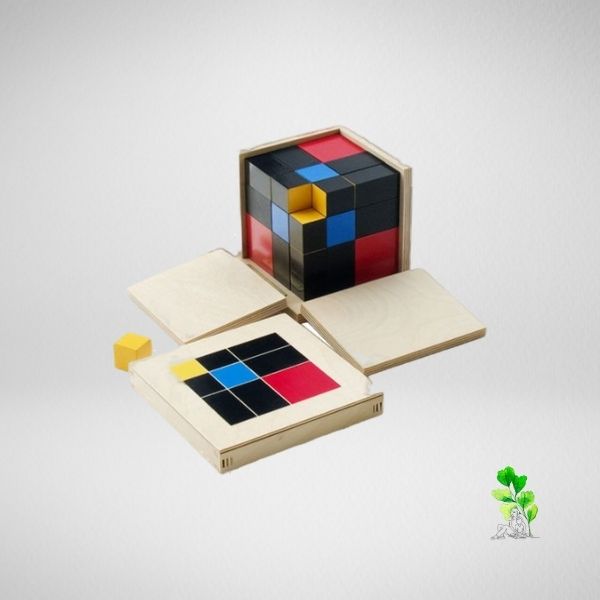
Description:
The trinomial cube consists of 27 painted wooden cubes that fit exactly into a wooden box that is hinged and opens out to display the cubes. The box has a lid in which is printed the trinomial square pattern.
Purpose:
During early childhood, when the task is to build the trinomial cube, this material helps the child understand the three dimensions and 3-dimensional puzzles. It enhances concentration and problem solving skills. Working with the cube also prepares them for using the same cube for algebra in later years.
How to work with the trinomial cube
Where to buy: Nienhuis $198.50 | Montessori Outlet $53.95 | Shopee ₱1,000
Where Else to Buy Montessori Materials in the Philippines
If you’re living in the Philippines like I am, there are other sources of Montessori materials within the country, such as:
Five Senses Educational Materials (FSEM) Montessori Materials PH
You can message them directly for a catalog of the materials that they sell and their price list.
Montessori Philosophy > Materials
Even though this is an article specifically about Montessori materials, I would just like to emphasize once again that the philosophy is more important than the materials. You *don’t* have to spend a fortune on the materials and many of them can be improvised or DIYed at home. What is important is that you read up on how to present them, let your child learn at their own pace, and most importantly, inculcate a lifelong love of learning.
LEARNING AND GROWING
Learning / Education
Financial Education for Kids
Inspiration for Kids
LEARNING ABOUT THE WORLD
Books
Environmental Issues
Philippine Heritage and Culture
World History, Arts and Culture
